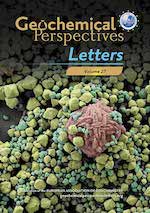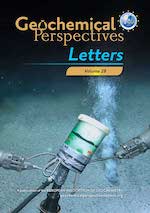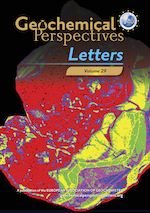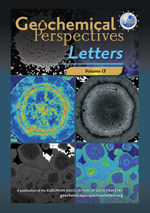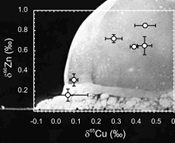 | Moderately volatile element behaviour at high temperature determined from nuclear detonation Abstract: The first nuclear detonation, at the Trinity test site, is an analogue for high temperature volatile loss during planet formation processes. We report Cu isotope and abundance data, comparing them with Zn and K isotopes in trinitite glasses sampled with distance from the detonation centre. Copper concentrations drop, and isotopic compositions become ~0.3 ‰ higher with proximity to the detonation. Relative sensitivity to high temperature evaporative isotopic fractionation processes occur in the order: Zn > Cu >> K. Lower volatility of K relative to Cu and Zn results from its low activity coefficient in silicate melts. Lunar mare basalt and some tektite Cu, Zn and K isotope compositions can be modelled using empirical fractionation factors (α) derived from trinitite. Combined with isotopic variations measured in mare basalts, the results support volatile loss during a magma ocean phase for the Moon. |
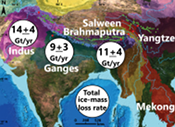 | Tracing ‘Third Pole’ ice meltwater contribution to the Himalayan rivers using oxygen and hydrogen isotopes Abstract: Global warming is adversely affecting the melting rates of Himalayan glaciers, which feed a number of large river systems in the Indian sub-continent. Regional scale assessment of glaciers and their link to rivers are mostly quantified using remote sensing data and modelling techniques. Here we present an alternative stable water isotope modelling approach. New oxygen and hydrogen isotopes (18O/16O and 2H/1H, expressed as δ18O and δD) data from the headwater of Indus River were analysed with a comprehensively compiled δ18O and δD dataset of Himalayan rivers to quantify the volumetric flow of glacier ice meltwater in the headwaters of the rivers Indus, Ganges, and Brahmaputra. The isotope mixing model reveals that the discharge weighted annual average glacier ice meltwater contribution in headwaters (>2000 m) of the Indus, the Ganges, and the Brahmaputra are 47 ± 13 %, 44 ± 13 %, and 29 ± 10 %, respectively, which corresponds to a minimum of 33.5 ± 6.5 Gt yr-1 of melted ice mass. Our results show that annual glacier ice meltwater contributions vary across the river basins, with Indus River receiving the highest contribution. We conclude that stable water isotope modelling is an alternative approach to study regional scale glacier-river interactions to address the future impact of climate change over glaciated Himalayan catchments. |
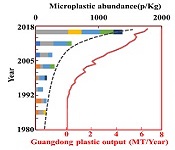 | Forty-year pollution history of microplastics in the largest marginal sea of the western Pacific Abstract: Marine sediments have been considered to be a major sink for microplastics, yet the pollution history of microplastics recorded in these sediments remains poorly understood. Using a combination of 210Pb chronology and quantification of microplastics in undisturbed sediment cores, here we established the forty-year pollution history of microplastics in the northern South China Sea (SCS), the largest marginal sea of the western Pacific. We found that the pollution of microplastics in the northern SCS commenced in the 1980s. A dramatic increase of microplastic abundance in about 1998 marked an important breakpoint for microplastic contamination. Since then, microplastic abundances in the sediments have continued to increase and reached the highest level in 2018. This was well in line with the increasing trend of plastic output in the local industries. Reconstructing regional pollution history further revealed the shift of microplastic depocentres in the northern SCS over the past forty years. We estimated that the microplastic abundances in the sediments at nearshore stations will double by 2028. Our results provide the first example of the reconstruction of microplastic pollution history in marine sediments and new insights into how microplastics contaminated the marginal sea. |
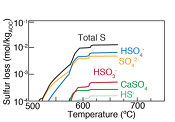 | Sulfur loss from subducted altered oceanic crust and implications for mantle oxidation Abstract: Oxygen fugacity (fO2) is a controlling factor of the physics of Earth’s mantle; however, the mechanisms driving spatial and secular changes in fO2 associated with convergent margins are highly debated. We present new thermodynamic models and petrographic observations to predict that oxidised sulfur species are produced during the subduction of altered oceanic crust. Sulfur loss from the subducting slab is a function of the protolith Fe3+/ΣFe ratio and subduction zone thermal structure, with elevated sulfur fluxes predicted for oxidised slabs in cold subduction zones. We also predict bi-modal release of sulfur-bearing fluids, with a low volume shallow flux of reduced sulfur followed by an enhanced deep flux of sulfate and sulfite species, consistent with oxidised arc magmas and associated copper porphyry deposits. The variable SOx release predicted by our models both across and among active margins may introduce fO2 heterogeneity to the upper mantle. |
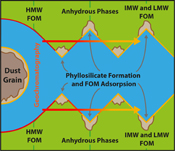 | Concentration of meteoritic free organic matter by fluid transport and adsorption Abstract: Carbonaceous chondrites contain many abiotic organic compounds, some of which are found in life on Earth. Both the mineral and organic matter phases, of these meteorites, have been affected by aqueous alteration processes. Whilst organic matter is known to be associated with phyllosilicate phases, no such relationship has yet been identified for specific organic compound classes. Furthermore, ongoing sample return missions, Hyabusa 2 and OSIRIS-Rex, are set to return potentially organic rich C-type asteroid samples to the Earth. Consequently, strategies to investigate organic-mineral relationships are required. Here we report spatial data for free/soluble organic matter (FOM/SOM) components (akylimidazole and alkylpyridine homologues) and mineral phases. Low and intermediate molecular weight alkylimidazole homologues are more widely distributed than higher molecular weight members, likely due to their affinity for the aqueous phase. On aqueous alteration of anhydrous mineral phases, transported FOM is adsorbed onto the surface or into the interlayers of the resulting phyllosilicates and thus concentrated and protected from oxidising fluids. Therefore, aiding the delivery of biologically relevant molecules to earth, shortly preceding the origin of life. |
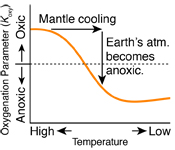 | Mantle cooling causes more reducing volcanic gases and gradual reduction of the atmosphere Abstract: The early atmosphere contained negligible O2 until the Great Oxidation Event (GOE) around 2.4 Ga, but evidence suggests that production of photosynthetic O2 began hundreds of millions of years earlier. Thus, an ongoing debate concerns the trigger of the GOE. One possibility is that volcanic gases became more oxidising over time. Secular cooling of the mantle affects thermodynamic equilibria and also changes the proportions of reduced and oxidised volcanic gases. Here, we examine the consequences of mantle cooling for the evolution of Earth’s atmospheric redox state. Contrary to some previous hypotheses, we show that as the mantle cools, volcanic emissions contain a greater proportion of reducing gases, which produces a more reducing atmosphere. However, the atmosphere became more oxic. Therefore, the redox consequences of other processes, such as secular oxidation of the mantle and/or hydrogen escape to space, must have dominated over that of mantle cooling in shaping the redox evolution of Earth’s atmosphere. |
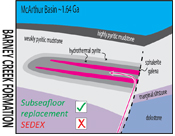 | Massive sulfide Zn deposits in the Proterozoic did not require euxinia Abstract: Our most important Zn resources occur within clastic-dominated (CD-type) deposits, which are located in a small number of Proterozoic and Phanerozoic sedimentary basins. The most common model for CD-type mineralisation involves sedimentary exhalative (SEDEX) processes, i.e. the venting of metal bearing fluids into a restricted, anoxic H2S-bearing (euxinic) water column. In the Carpentaria Zn Province (Australia), multiple world class deposits are hosted in Proterozoic (1.6 Ga) stratigraphy, where models of the ancient sulfur cycle have also been developed. Focusing on the most recent discovery – the Teena deposit – we report bulk rock and isotopic data (δ34Spyrite values) that provide information on the sulfur cycle during the diagenetic and hydrothermal evolution of the Teena sub-basin. In contrast to the SEDEX model, intervals containing abundant pyrite with highly positive δ34S values (>25 ‰) correspond with euxinic conditions that developed due to high organic loading (i.e. productivity) and not basin restriction. This basin wide feature, which can also be mistaken as a hydrothermal pyrite halo, is genetically unrelated to the subsequent hydrothermal mineralisation that formed beneath the palaeo-seafloor. The formation of CD-type deposits in the Proterozoic does not, therefore, require euxinic conditions. |
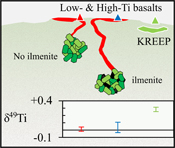 | Unravelling lunar mantle source processes via the Ti isotope composition of lunar basalts Abstract: Formation and crystallisation of the Lunar Magma Ocean (LMO) was one of the most incisive events during the early evolution of the Moon. Lunar Magma Ocean solidification concluded with the coeval formation of K-, REE- and P-rich components (KREEP) and an ilmenite-bearing cumulate (IBC) layer. Gravitational overturn of the lunar mantle generated eruptions of basaltic rocks with variable Ti contents, of which their δ49Ti variations may now reflect variable mixtures of ambient lunar mantle and the IBC. To better understand the processes generating the spectrum of lunar low-Ti and high-Ti basalts and the role of Ti-rich phases such as ilmenite, we determined the mass dependent Ti isotope composition of four KREEP-rich samples, 12 low-Ti, and eight high-Ti mare basalts by using a 47Ti-49Ti double spike. Our data reveal significant variations in δ49Ti for KREEP-rich samples (+0.117 to +0.296 ‰) and intra-group variations in the mare basalts (-0.030 to +0.055 ‰ for low-Ti and +0.009 to +0.115 ‰ for high-Ti basalts). We modelled the δ49Ti of KREEP using previously published HFSE data as well as the δ49Ti evolution during fractional crystallisation of the LMO. Both approaches yield δ49TiKREEP similar to measured values and are in excellent agreement with previous studies. The involvement of ilmenite in the petrogenesis of the lunar mare basalts is further evaluated by combining our results with element ratios of HFSE, U and Th, revealing that partial melting in an overturned lunar mantle and fractional crystallisation of ilmenite must be the main processes accounting for mass dependent Ti isotope variations in lunar basalts. Based on our results we can also exclude formation of high-Ti basalts by simple assimilation of ilmenite by ascending melts from the depleted lunar mantle. Rather, our data are in accord with melting of these basalts from a hybrid mantle source formed in the aftermath of gravitational lunar mantle overturn, which is in good agreement with previous Fe isotope data. |
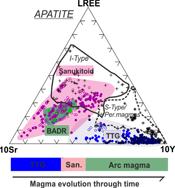 | Accessory mineral constraints on crustal evolution: elemental fingerprints for magma discrimination Abstract: Underexplored accessory minerals such as titanite and apatite have the potential to give insights into the nature and the petrogenesis of their host rock. Their trace element and REE-rich compositions carry a record of crystallisation history and chemical characteristics of their source. Moreover, titanite and, to a certain extent, apatite are resistant to erosion during sedimentary cycles which makes them ideal to reconstruct the history of long-eroded continental landmasses. Here we report new trace element data on apatite and titanite from granitoids of different Archean cratons and comparative granitoids from the Phanerozoic. Trace element signatures of both minerals reveal systematic chemical trends in Y, LREE and Sr contents related to the nature of their host magma, which are used to construct discrimination diagrams delineating Archean TTGs from sanukitoids, and modern adakites from S/I-type granites. By comparing Archean granitoids (TTG and sanukitoids) and their Phanerozoic counterparts (adakite and high Ba-Sr granites), we show that the robust nature of these phases makes them reliable recorders of petrogenetic information from Archean rocks, that usually have been affected by secondary processes (metamorphism, deformation, hydrothermal activity). Applied to the rock record, both phases potentially provide detailed archives of magmatic evolution through time. |
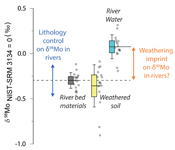 | Unravelling the controls on the molybdenum isotope ratios of river waters Abstract: The molybdenum (Mo) isotope ratios (δ98/95Mo) of river waters control the δ98/95Mo values of seawater and impact on the use of Mo isotope ratios as a proxy of past redox conditions. The δ98/95Mo values of river waters vary by more than 2 ‰, yet the relative roles of lithology versus fractionation during weathering remain contested. Here, we combine measurements from river waters (δ98/95Modiss), river bed materials (δ98/95MoBM) and soils from locations with contrasting lithology. The δ98/95Mo values of river bed materials (δ98/95MoBM), set by rock type, vary by ~1 ‰ between rivers in New Zealand, the Mackenzie Basin, and Iceland. However, the difference between dissolved and solid phase Mo isotopes (Δ98/95Modiss-BM) varies from +0.3 ‰ to +1.0 ‰. We estimate Mo removal from solution using the mobile trace element rhenium and find that it correlates with Δ98/95Modiss-BM across the sample set. The adsorption of Mo to Fe-Mn-(oxyhydr)oxides can explain the observed fractionation. Together, the amount of Mo released through dissolution and taken up by (oxyhydr)oxide formation on land may cause changes in the δ98/95Mo values of rivers, driving long term changes in the Mo isotope ratios of seawater. |
<< Previous issueNext issue >>


